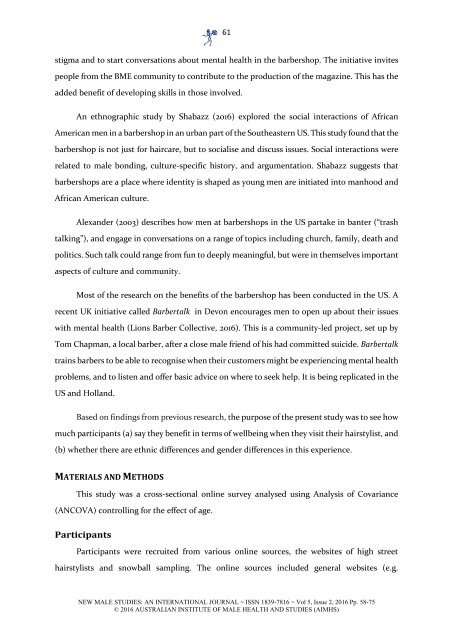IS HEALTH?
article-5
article-5
Create successful ePaper yourself
Turn your PDF publications into a flip-book with our unique Google optimized e-Paper software.
61<br />
stigma and to start conversations about mental health in the barbershop. The initiative invites<br />
people from the BME community to contribute to the production of the magazine. This has the<br />
added benefit of developing skills in those involved.<br />
An ethnographic study by Shabazz (2016) explored the social interactions of African<br />
American men in a barbershop in an urban part of the Southeastern US. This study found that the<br />
barbershop is not just for haircare, but to socialise and discuss issues. Social interactions were<br />
related to male bonding, culture-specific history, and argumentation. Shabazz suggests that<br />
barbershops are a place where identity is shaped as young men are initiated into manhood and<br />
African American culture.<br />
Alexander (2003) describes how men at barbershops in the US partake in banter (“trash<br />
talking”), and engage in conversations on a range of topics including church, family, death and<br />
politics. Such talk could range from fun to deeply meaningful, but were in themselves important<br />
aspects of culture and community.<br />
Most of the research on the benefits of the barbershop has been conducted in the US. A<br />
recent UK initiative called Barbertalk in Devon encourages men to open up about their issues<br />
with mental health (Lions Barber Collective, 2016). This is a community-led project, set up by<br />
Tom Chapman, a local barber, after a close male friend of his had committed suicide. Barbertalk<br />
trains barbers to be able to recognise when their customers might be experiencing mental health<br />
problems, and to listen and offer basic advice on where to seek help. It is being replicated in the<br />
US and Holland.<br />
Based on findings from previous research, the purpose of the present study was to see how<br />
much participants (a) say they benefit in terms of wellbeing when they visit their hairstylist, and<br />
(b) whether there are ethnic differences and gender differences in this experience.<br />
MATERIALS AND METHODS<br />
This study was a cross-sectional online survey analysed using Analysis of Covariance<br />
(ANCOVA) controlling for the effect of age.<br />
Participants<br />
Participants were recruited from various online sources, the websites of high street<br />
hairstylists and snowball sampling. The online sources included general websites (e.g.<br />
NEW MALE STUDIES: AN INTERNATIONAL JOURNAL ~ <strong>IS</strong>SN 1839-7816 ~ Vol 5, Issue 2, 2016 Pp. 58-75<br />
© 2016 AUSTRALIAN INSTITUTE OF MALE <strong>HEALTH</strong> AND STUDIES (AIMHS)


